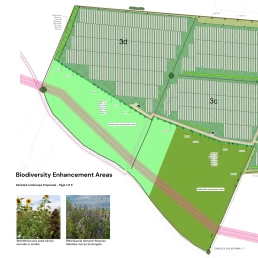TotalEnergies places a strong emphasis on the delivery of landscape and biodiversity enhancements. The development will deliver an overall biodiversity net gain of 31.63% in local habitats and 57.71% in surrounding hedgerows, while maintaining grazing areas on suitable areas of the site.
Our initiatives aim to preserve and enhance the local landscape, encourage wildlife, and promote sustainability. Here’s how we’re achieving these goals:
Key objectives
- Landscape preservation and enhancement: We are committed to preserving existing landscape features and supplementing them with new plantings to enhance the overall landscape. Our plans include extensive new hedgerows, hedgerow trees, and woodland plantings.
- Biodiversity enhancement: Encouraging wildlife and enhancing biodiversity is important to us. We are implementing a series of measures to ensure a rich and diverse ecosystem within the proposed site.
- Sustainable agriculture: By reducing the use of chemical fertilizers and managing nitrate levels, we aim to mitigate soil degradation. Livestock will continue to graze under the solar panels, maintaining the farm’s primary agricultural use.
- Local sustainability initiatives: Our project contributes to local sustainability goals and will improve community facilities within the site and surrounding area.
The map below shows the biodiversity enhancement landscape proposals planned for the site:
Landscape Proposals
New native hedgerow field boundaries including hedgerow trees, and new native woodland and shrub planting would conserve and enhance the landscape structure within the Site, which in turn would be beneficial in terms of strengthening local landscape character taking account of the landscape management strategy for Landscape Character Area (LCA) Aii Undulating Mixed Farmlands, (identified in the 2022 Rutland Landscape Character Assessment), which the Site is located within.
Hedgerow and tree management:
Existing hedgerows and trees will be managed and enhanced with new infill planting. We will plant new native hedgerows and trees, including species like Hawthorn, Field Maple, Hazel, Holly, Blackthorn, Dog Rose, and Guelder Rose.
Wildflower grasslands:
New species-rich wildflower grasslands will be established along field margins and within designated biodiversity enhancement areas (BEAs), promoting vibrant and diverse flora. This will enable a range of species to thrive.
Vegetation retention:
We will preserve existing vegetation across the site wherever possible, except for access purposes. Mature field trees will be retained and integrated into the development.
Ecological Proposals
Habitat avoidance and enhancement:
Our design will avoid impacting high-value habitats, focusing instead on enhancing field boundaries, trees, hedgerows, ditches, and ponds.
Wildflower meadows and native plantings:
Wildflower meadows will be created under proposed hedgerows and within enhanced areas. Native scrub planting and woodland cover will further enrich the area, making it a suitable habitat for species.
Tree and hedgerow planting:
We will plant 1,022 meters of new hedgerows, 95 meters of hedgerow infill, and 156 new trees, enhancing the site’s appearance. The hedgerows would provide an invertebrate food source and foraging route for bats to feed and commute.
Wildlife provisions:
- 15 bird boxes will be installed on semi-mature and mature trees to support avian populations.
- 15 bat roost boxes will be placed on suitable trees to aid bat conservation.
- 10 hedgehog boxes will be located in sheltered, undisturbed areas.
- 10 insect hotels will be erected to support invertebrate life.
- At least five hibernacula, constructed from logs and clean bricks or rubble, will provide shelter for amphibians, reptiles, small mammals, and invertebrates.
Monitoring and maintenance:
An experienced ecologist will monitor the site over time, conducting walkover surveys in years 1, 3, 5, and 10 to ensure the effectiveness of our ecological measures.
Through these initiatives, Staveley Solar Farm will not only generate renewable energy, but will also enhance the surrounding natural environment, having a positive impact on the local ecosystem and community. Careful maintenance and management of the proposed trees and hedgerows over the period of 40 years that the solar farm would be in operation and beyond would ensure they continue to thrive.
Agricultural benefits:
As approximately 95% of the Site remains available for sheep grazing, the National Farmers Union support solar schemes such as this project as it allows farms to diversify which in turn helps keeps farmers in business, allows farmers to continue to farm sustainably, employs local people and provides investments locally, whilst improving the land and soil quality for future generations to come.
Grazing sheep under and around solar panels is the most cost-effective way of maintaining the land, which has the potential to increase the level of carbon sequestered by the grassland over the 40 years of the operation of the Solar Farm. It will significantly increase the soil organic matter which will increase long-term fertility and soil workability.
Read more about our environmental enhancement plans here.

